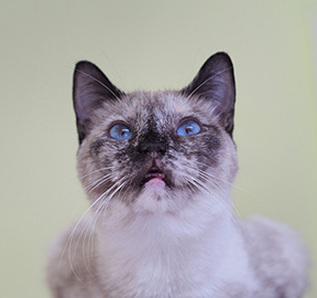
Cat guardians may only see them when their favorite felines yawn or throw hissy fits, but they’re there. Your cat’s teeth!
Thirty to be precise, in any cat older than 6 months: four molars, ten pre-molars, four canines and twelve incisors. Unlike a person’s teeth with their focus on chewing, a pussycat’s teeth focus heavily on grinding and chopping.
Needless to say, your cat needs clean, sharp teeth and healthy gums. Damage to the tongue and teeth, palate and gums can pose numerous health risks to them, most of which can be prevented by regular home check-ups, including brushing. (Signs of possible dental problems include excessive pawing at the mouth area, excessive drooling, difficulty chewing food, and pus).
To accustom your cat to having her teeth brushed, begin by gently massaging her gums with your finger or lightly touching them with a cotton swab. After several sessions, dab a small amount of specially cat-formulated toothpaste on her lips to get her used to the taste. Next, use a toothbrush specifically designed for cats or one that can be worn over your finger. Apply the toothpaste to her teeth and brush them gently.
Besides brushing, chew toys will satisfy your cat’s natural desire to chomp, while also strengthening her teeth. Gnawing on a chew toy will also help floss her teeth, massage her gums, and scrape away soft tartar.
To determine the overall health of your cat’s mouth, face your feline, gently push back her lips and study her gums, which should be firm and pink without signs of swelling, while her teeth should be clean, neither loose nor broken, and free of any brownish, hardened tartar.
Conditions requiring a prompt visit to the vet include:
Gingivitis: This inflammation of the gums occurs mainly in older cats, often accompanied by an abnormally strong mouth odor, and may start as a dark red line along the gums bordering the teeth. If left untreated, the gums may become sore and ulceration may occur. This condition may also be a sign of FIV or other infections.
Periodontitis: If gingivitis invades the tooth socket, the tooth may become loose and an abscess may form.
Stomatitis: This inflammation of the mouth lining can be caused by the presence of a foreign object, a viral disease or dental problems. Your cat will have difficulty eating and the inside of her mouth will appear red.
Rodent ulcer: This is a slowly enlarging sore or swelling on the upper lip.
Salivary cyst: When salivary glands or ducts carrying saliva to the mouth become blocked, a cyst may form under the tongue.
Mouth ulcers: Ulcers on a cat’s tongue and gums can be caused by feline respiratory or kidney disease.
If you’ve been neglecting your cat’s dental health up to now, it is never too late to start.









 RSS Feed
RSS Feed